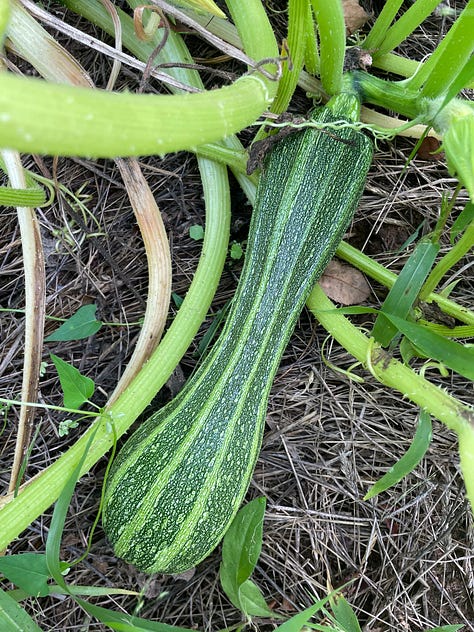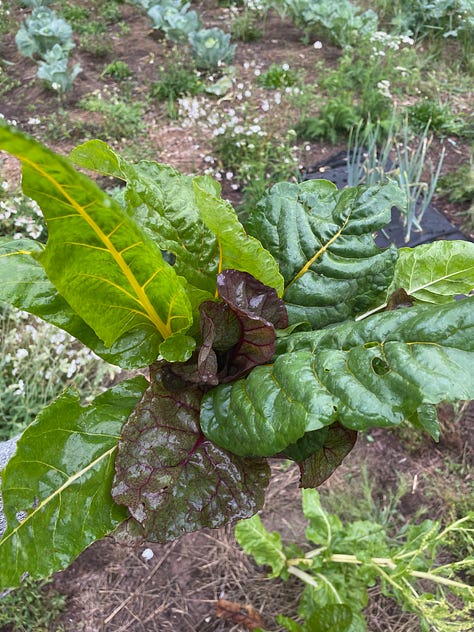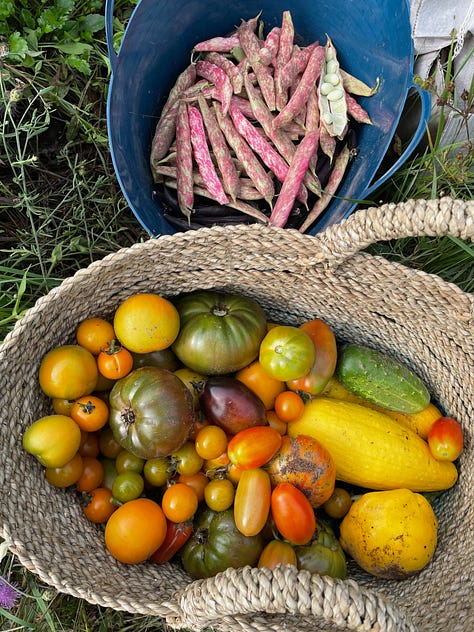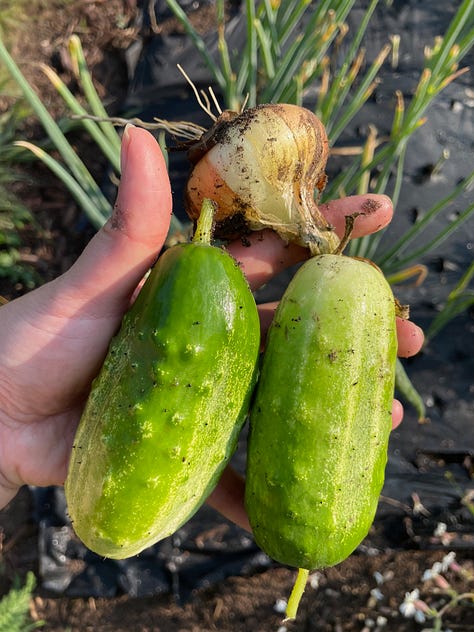A love letter to September
Garden recap, produce rx news, & a new seasonal living recommendation
Hello friends,
I’m traveling a bit this week and with that comes the opportunity to write. As the garden season comes to a close, I’m looking forward to the seasonal shift inward with more time for reflection and writing. In this newsletter, you’ll find my 2023 garden recap, exciting news in the world of produce prescription programs, a new seasonal living account you must follow, & more. I hope you enjoy it and this beautiful seasonal transition into Autumn.
In the Garden
September may be my favorite month of the year. It most certainly is in the garden. After record breaking heat over the Labor Day weekend, a cold front ushered in seasonal temperatures and hints of color among the tree filled hillsides. Over the coming days, we pulled in baskets of assorted beans, our largest onion crop to date, and plenty of cabbage for sauerkraut and curtido (a favorite ferment in our household). Sadly, our tomato crop suffered with a heat wave that hit a bit too late. Sweet September has come and nearly gone…and I don’t know about you, but I’m ready to savor the slow down. Below you’ll find a few highlights from my farmacy.






1. Costata Romanesco Zucchini 2. Swiss Chard 3. Bush Bean Blend
4. Rainbow Tomatoes and Tongue of Fire Beans 5. Onions & Cucumbers 6. Caraflex Cabbage
Journal Club
Did you know that doctors and other health professionals can write prescriptions for fruits and vegetables? Yes, it’s true!
I’m thrilled to share a landmark paper in support of produce prescription programs released in late August. In the journal Circulation, researchers found that “people at increased risk for cardiovascular disease who participated in a produce prescription program for an average of 6 months increased their consumption of fruits and vegetables and reduced blood pressure, body mass, and blood sugar levels.” This pooled analysis is the largest produce prescription study to date from nine programs across the U.S. to assess health outcomes after 6 months. These findings provide important new evidence which will continue to shape clinical protocols and health policy necessary for scaling across health systems and payer formularies. This is a very exciting time for the “food is medicine” movement!
If you’re new here, you may not know that produce prescription programs (produce rx) are near and dear to my heart. As a rural family medicine physician, I implemented a produce rx program called Prescription for Health. In 2016 produce rx programs were still rather novel and this was my first deep dive into the “food is medicine” movement as well as program design, implementation, evaluation, and grant writing (phew)!
The pilot program enrolled a small cohort of adult patients from my primary care practice and provided them with vouchers to purchase fresh fruits and vegetables from our local farmer’s market. Participants also received seasonal recipes and health coaching from a community health worker at the farmer’s market. Over the course of 10 weeks, most physical health outcomes (like those above) remained unchanged, but there was a statistically significant improvement in quality of life among program participants. This was truly a light bulb moment for me in that changing lives for the better is at the heart of what I aspire to do as a physician and set me on a path to connect food systems and health systems. I’ll share more about that journey in future newsletters.
I published my findings from the pilot program in the journal of Health Promotion Practice in 2022 and have spoken about my Prescription for Health experience on the podcast interview linked below:
Publication:
"Something Fun to Look Forward to": Lessons From Implementing the Prescription for Health Farmers' Market Initiative in Rural Upper Michigan. Joseph, C. and Seguin, M. Health Promotion Practice. 2023 Sep;24(5):903-910.
Podcast Interview:
One to Follow
Seasonal living is a tenant of my personal health philosophy and one that I often share about through my teachings and on social media. Cycles, rhythms, and seasons are ways in which nature guides our physiology and psychology. If you are looking to deepen your relationship with the seasons, please consider following
on Substack. I’ve been a member of Megan’s online gardening community, The Fresh Exchange, for the past 2 years and can attest to the caliber of her teachings (& writing) in terms of quality, creativity, and passion. I’m continually inspired by her work and I know you will be too.Tune into her most recent podcast episode to learn more about her story.
A Piece of My Mind
A few of you have asked me to bring back this feature of the former newsletter where I share quick updates on what I’m learning, doing, loving, & more! The title of this segment is a riff on the popular JAMA series, which often highlights the joys, challenges, and hidden truths of practicing medicine in the modern era. Both are enjoyable, yet mine may be a bit more lighthearted.
What I’m reading: “The Well-Gardened Mind: The Restorative Power of Nature” by fellow doctor-gardener Dr. Sue Stuart-Smith
What you may find helpful: “How to Shop for Food - Refining your approach at the market” is another great read by
as we walks through his approach to shopping, cooking, and eating in season.What I’m loving: I adore this travel teapot by Rishi Tea & Botanicals. I really like to travel with tea and often think of it as an extension of my medicine kit. Have a tummy ache? A sore throat? Can’t sleep? Feel a cold coming on? There’s a tea for that!
What I’m making: Zucchini Carpaccio with my homegrown costata romanesco zucchini (pictured above) from Amy Thielen’s latest cookbook “Company: The Radically Casual Art of Cooking for Others”. This was undoubtedly the best garden meal of the season. More on this cookbook in an upcoming Substack newsletter.
What you may want to eat more of: Ginger! A new study published last week reveals promising research on ginger supplementation and anti-inflammatory response in autoimmune conditions. I prefer a food first approach and encourage you to explore more ways to increase ginger in your diet especially as the weather turns cooler. Ginger tea, ginger juice shots, and carrot ginger soup are among my favorites.
This newsletter is a work in progress and your feedback is valuable to me. If there are topics of interest or columns you’d like featured, please connect with me and/or leave a comment. Thanks for being here!
Yours in health,
Dr. Michelle
P.S. If you are enjoying this newsletter, I’d love if you’d share it with a home cook, gardener, and/or nature lover in your life!





Love that you co-authored the paper on produce prescriptions. Well done!
I’m really looking forward to learning more about your work about connecting food systems and health systems Michelle.
I do remember you talking about that when our paths crossed in a different space on the internet. It’s an interesting space.